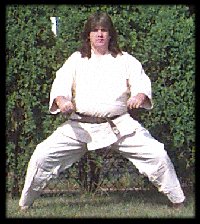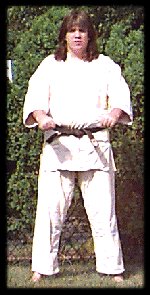| Stances | ||
| Links |

|
Kiba-Dachi Kiba-dachi, or "horse-riding stance" is one of the basic training stances of Shotokan. It's name is derived from the fact that the stance looks as if the practioner is riding a horse. When in the stance, the feet are parallel to each other and about two shoulder widths apart. The knees are pushed out to the sides so that the legs are bowed. Grip the floor with your toes. You should feel pressure on the outer edges of your feet if your knees are pushing out properly. When looked at from the front, the stance should look as if the practioner is riding a horse. Since the stance is quite wide, it is very strong from the side. However, because the stance is not very long, it is very weak from the front and back. |
|
Home
|
||
|
Dojos
|
||
|
Testing and
Belt Levels
|
||
|
Blocking
Techniques
|
||
|
Kicking
Techniques
|
||
|
Katas
|
||
|
Punching
Techniques
|
||
|
Stances
|
Hachi-Dachi Hachi-dachi, or "ready stance" is one of the natural posture stances of Shotokan. From hachi-dachi, you can move into any other stance. When in the stance, the feet are parallel to each other and about one shoulder widths apart. The knees are slightly bent. Grip the floor with your toes. |

|
|
Winsted
Karate Club
|
||
|
Shotakan of
America
|
||

|
Kokutsu Dachi Kokutsu-dachi, or "Back stance" is one of the fighting stances of Shotokan. From here, the practioner can move forward and back, turn and throw any number of techniques. When in the stance, the feet are perpendicular to each other and about one and a half shoulder widths apart. The heel of the forward foot points to the heel of the midpoint of the base foot. The forward knee is bent and in line with the foot. The knee of the base leg is also bent, and pushed out to the side. The shoulders are directly over the hips and square. The trunk faces the same direction as the base foot, but head looks in the direction of the forward foot. Grip the floor with your toes. This stance is extremely strong from the side. In fact, when pushed from the side, the practioner should not be able to be moved backward. Also, when done correctly, the practioner should be able to kick with the lead leg without having to shift his/her weight. |
|